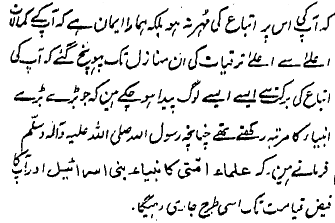Showing Islam is Peaceful • Tolerant • Rational • Inspiring
| Home
|
| 1.
Islam |
| 2.
Ahmadiyya Movement Refuting the Qadiani Beliefs Pre-Split beliefs in Ahmadiyya Movement that no prophet can come after Prophet Muhammad Earlier beliefs of leading figures of the Qadiani Jama‘at Mirza Mahmud Ahmad wrote in 1911 that all types of prophethood ended with Prophet Muhammad |
| 3.
Publications & Resources |
Mirza Mahmud Ahmad wrote in 1911 that all types of prophethood ended with Prophet MuhammadThe Khalifa of the Qadiani group, Mirza Bashir-ud-Din Mahmud Ahmad (their leader from 1914 to 1965), wrote an article entitled Khatam-un-Nabiyyin which was published both in Al-Hakam, 14 March 1911 (p. 10), and in Badr, 23 March 1911 (p. 2). Click this link to view the page in Al-Hakam and click this link to view the page in Badr containing the article. (Both are in pdf format.) Mirza Mahmud Ahmad wrote in this article as follows about the Holy Prophet Muhammad:
As to who can come after the Holy Prophet Muhammad, he uses the term mamur or one appointed by God. Nowhere does he say that a prophet can come after the Holy Prophet or that Hazrat Mirza appeared as a prophet. He also writes:
It is clearly acknowledged here that it is in accordance with this hadith of the Holy Prophet Muhammad that all the great spiritually-elevated persons in the history of Islam arose, among them Hazrat Mirza Ghulam Ahmad. They were the likes of prophets, not prophets. Quote from Hazrat Mirza’s bookAfter the end of the article in Al-Hakam, the Editor has added a quote from a book by Hazrat Mirza, as if to support the article. The extract has been headed: Belief of the Mahdi about the finality of prophethood. Although no reference is given, the quote is from the book Anjam Atham, published 1897, and begins as follows:
This proves that the standpoint of Hazrat Mirza Ghulam Ahmad about his claim was still accepted in 1911. For interest, the text in Anjam Atham immediately before the above words is as follows:
And the text in Anjam Atham immediately after the quote given in Al-Hakam is as follows:
Therefore, this explanation of his claims given by him in 1897 is confirmed as valid and correct in Al-Hakam in 1911, and in fact Al-Hakam quotes this in support of Mirza Mahmud Ahmad’s article. |

